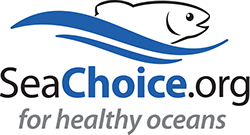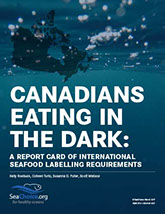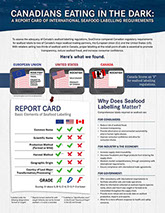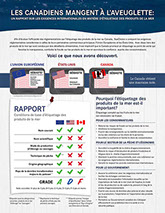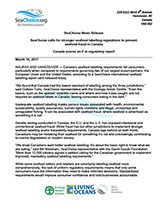Label My Seafood
Businesses and consumers deserve
to know more about the fish they buy.
Canada’s seafood labelling
regulations are missing the mark.
Let’s Stop Eating in the Dark.
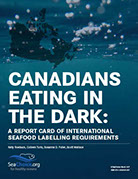
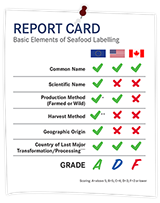
SeaChoice asked, and Canadians answered.
Over 12,700 Canadians agree that the government should have stronger seafood labelling regulations that should include:
&
The species
scientific name
How it was
caught or farmed
Where it was
caught or farmed
Whether it's
wild or farmed
Traceability systems to ensure the accuracy of these label claims
We submitted our recommendations to the Canadian Food Inspection Agency (CFIA) along with the support of 12,705 Canadians. Now we need your help to ensure that the changes we are advocating for are heard.
Sign up to our email list to follow our progress and to learn more about seafood fraud and mislabelling in Canada.
Better Seafood Labelling Helps Businesses and Consumers make more Environmentally, Socially and Economically Sustainable Choices.
 An informed consumer is a powerful consumer. Given the state of our oceans and our collective need to feed the planet we must support sustainable seafood sources. It’s the only way forward.
An informed consumer is a powerful consumer. Given the state of our oceans and our collective need to feed the planet we must support sustainable seafood sources. It’s the only way forward.
Michael Smith, Food Network Host,
Author and Proprietor, The Inn at Bay Fortune
 The fishing industry supports better seafood labelling because we have made significant investments in sustainable fishing and want retailers and consumers to know what they are buying.
The fishing industry supports better seafood labelling because we have made significant investments in sustainable fishing and want retailers and consumers to know what they are buying.
Brian Mose, 5th generation fisherman, Executive Director of the Deep Sea Trawlers Association
 Misrepresentation drives consumers to buy products which are less than what they thought they were paying for and at the expense of legally caught and honestly labeled seafood provided by trustworthy vendors. Imposing a legal obligation upon all links in the supply chain to maintain the integrity of seafood labeling and accurately represent the underlying product protects consumers and legitimate suppliers alike.
Misrepresentation drives consumers to buy products which are less than what they thought they were paying for and at the expense of legally caught and honestly labeled seafood provided by trustworthy vendors. Imposing a legal obligation upon all links in the supply chain to maintain the integrity of seafood labeling and accurately represent the underlying product protects consumers and legitimate suppliers alike.
Dane Chauvel, President, Organic Ocean Seafood Inc
 As a Chef who feeds thousands of people a year, in a country surrounded by three oceans, and as a father, the sustainability of the seafood I serve and eat is extremely important. That's why I believe knowing the what, where, how and who of our seafood is too important to ignore. I challenge us all to demand better seafood labelling in Canada — for the health of Canadians and the sustainability of our fish and seafood resources into the future.
As a Chef who feeds thousands of people a year, in a country surrounded by three oceans, and as a father, the sustainability of the seafood I serve and eat is extremely important. That's why I believe knowing the what, where, how and who of our seafood is too important to ignore. I challenge us all to demand better seafood labelling in Canada — for the health of Canadians and the sustainability of our fish and seafood resources into the future.
Ned Bell, Ocean Wise Executive Chef,
Founder, Chefs for Oceans
 According to a recent study by Dalhousie University, 42% of Canadians believed that they had purchased a counterfeited food product at some time, and seafood was the highest category selected. Consumers are recognizing that we have a huge challenge ahead.
According to a recent study by Dalhousie University, 42% of Canadians believed that they had purchased a counterfeited food product at some time, and seafood was the highest category selected. Consumers are recognizing that we have a huge challenge ahead.
Dr. Sylvain Charlebois,
Dean, Dalhousie University School of Management
 Seafood traceability and sustainability are at the forefront in our industry and it is crucial for the labels on all seafood to reflect the accuracy of this. Consumers nowadays want to know where their seafood is coming from and if it is caught in a sustainable manner. Having a proper label reflects all the hard work and dedication from the honest fishermen and seafood companies.
Seafood traceability and sustainability are at the forefront in our industry and it is crucial for the labels on all seafood to reflect the accuracy of this. Consumers nowadays want to know where their seafood is coming from and if it is caught in a sustainable manner. Having a proper label reflects all the hard work and dedication from the honest fishermen and seafood companies.
Sal Battaglia, VP, Seacore Seafood Inc.,
Distributor, Importer & Processor
 Canada exports about half a million tonnes of seafood each year, which means that many of our fish producers and processors are already working hard to be transparent and traceable, in an effort to meet the requirements of those countries importing Canadian fish and seafood. So they are already doing the hard part. Requiring Canadian labelling to include that information is an easy next step that will help to democratize seafood sustainability information to Canadian consumers.
Canada exports about half a million tonnes of seafood each year, which means that many of our fish producers and processors are already working hard to be transparent and traceable, in an effort to meet the requirements of those countries importing Canadian fish and seafood. So they are already doing the hard part. Requiring Canadian labelling to include that information is an easy next step that will help to democratize seafood sustainability information to Canadian consumers.
Dr. Megan Bailey, Assistant Professor Canada Research Chair Integrated Ocean and Coastal Governance, Dalhousie University
<
>
Why Should Canada Implement Better Seafood Labelling?


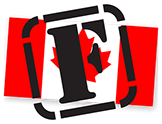
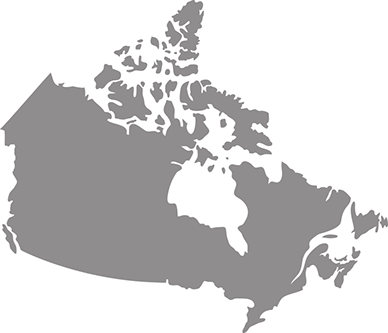
For Consumers
For Industry & the Economy
For Government
- Canadians are at risk of seafood fraud.
- Consumers deserve more transparency in their seafood information.
- Canadian seafood consumers may be unknowing contributors to environmental degradation and/or social injustice.
- With better labelling, businesses and consumers will be able to confidently buy seafood that supports the environmental and socio-economic sustainability they value.
- Major export markets demand higher standards from Canada
for seafood labelling. - New trade agreements are pressuring Canada to improve its labelling.
- To remain competitive, Canadian seafood needs to adhere to international requirements for traceability.
- Accurate and honest labelling requires supply chain traceability from the boat or farm to the plate.
- Canada is already required to comply with stricter labelling regulations to export its seafood to overseas markets, so why not at home?
- Canada already collects important information about its seafood imports (species name, along with where and how it was caught or farmed) – so it should be passed down to businesses, and to the end consumer.
- More detailed labelling and better traceability systems will provide more robust and accurate data on production, imports and exports, as well as allow the government to respond to health and safety issues more efficiently.
Our report found that Canada’s seafood labelling lags behind its primary trading partners (the EU and US).
Our report gave Canada an “F” for its failing seafood labelling regulations.
It’s time for Canadians to stop eating seafood in the dark.
Fishy Labels:
What Canadian Seafood Labels Don't Tell You
One Common Name can Represent Many Different
Species with Different Concerns
Tuna

14
If a species is simply listed as tuna,
it may or may not be:
- an endangered species
- from an IUU fishery
- overfished
- caught alongside large numbers of bycatch
- associated with human rights abuses
- high in mercury
Shrimp

40
If a species is simply listed as shrimp,
it may or may not be:
- responsible for habitat desctruction
- associated with human rights abuses
- caught alongside large numbers of bycatch
- ladden with chemicals,
pesticides and antibiotics
Rockfish

100+
If a species is simply labeled as Rockfish,
it may or may not:
- be an endangered species
- be overfished
- have ever had a stock assessment
Each of these common fish names can be used for a large number of different species.

63
Anchovy

21
Sole

200+
Snapper

125
Crab
<
>
So what can you do to help?
The next time you’re at the grocery store buying seafood,
be sure to ask:
● What species is this?
● Is it wild or farmed?
● Where is it from?
● How was it caught or farmed?
Then reference a sustainable seafood app or website,
like SeaChoice, to find out whether or not it’s a sustainable choice.
Share our website via Facebook or Twitter.
